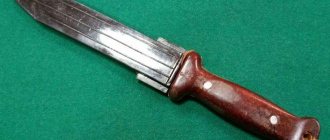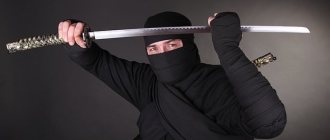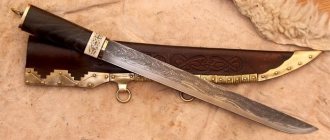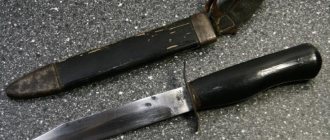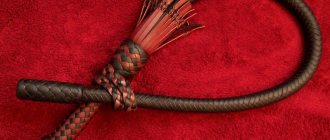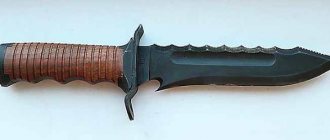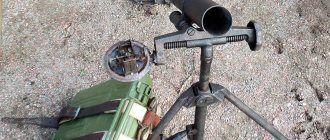The word “boarding” evokes in any of us associations with the heroes of Sabatini, Stevenson or Mine Reed - in other words, with pirates rushing on board a defenseless merchant ship. Some “experts” even attribute the invention of this weapon to the filibusters themselves. Let's figure out what a boarding saber was.
Story
This weapon owes its appearance to severe necessity: it was inconvenient to wield a long blade in the cramped conditions of a ship. The pirates allegedly shortened the blade and successfully operated with a compact weapon. Perhaps someone did just that - but it is still logical to assume that the authors of the new product were professional military sailors.
The army and navy have always responded much more quickly to changes in battle conditions and to the progress of weapons that could be used in them with maximum effect. Therefore, it is more likely that the boarding saber appeared first in the arsenal of military sailors, and only then migrated to the pirates. By the way, this statement is also supported by the fact that most sabers found by archaeologists have a more or less uniform shape and blade width. Consequently, they were made according to a certain standard, and were not made from blades picked up anywhere.
The first mention of this weapon dates back to the second half of the 17th century, and it successfully existed almost to the present day. This “survivability” of the boarding saber is explained by the fact that it was an ideal weapon for fighting in close quarters and did not need to be replaced. The wide blade left terrible wounds upon impact, which quickly became inflamed in the humid maritime climate. Given the level of development of medicine at that time, in most cases they led to death.
It is not surprising that this massive and heavy blade quickly gained popularity among sea robbers. Plus, it was very easy to learn how to use it. No touches, floss or other sophisticated fencing intricacies were required during boarding. Speed and pressure were needed, and the boarding saber fully corresponded to these qualities.
There is another version of its origin: the “progenitor” of the saber was a naval dirk, which received an elongated and widened blade, as well as a guard that protected the fingers from blows. It could also be used, like a brass knuckles, to deliver a crushing blow to the enemy’s face.
Ancient times
Nowadays, residents of more or less developed countries have long been accustomed to the fact that, if urgently needed, distances can be easily overcome. Any of them can be quickly and even comfortably crossed by plane, train or ship. But our ancestors did not have such technologies, and for a long time the only way to communicate between continents or with the coastal zone was only ships.
People started using them since time immemorial. Over time, their design changed for the better, which had a beneficial effect on speed, reliability and load capacity. When shipbuilding developed to the required level, battles often began to break out in the sea, and for a long time pirates were the threat of the seas and oceans. This continued until special counteraction units and naval flotillas were created, which were engaged in the protection of civilian ships or in the special capture of pirates. And probably the most favorite weapon of criminals were cutlasses. So what are they, why are they good and how were they used? We'll figure this out.
Cutting board device
This weapon had a slightly curved wide blade 60-70 cm long and up to 4-5 cm wide. Fullers were often missing (which would be nonsense if a long saber was made from a fragment). The sharpening was on the outside of the blade, but there were also one-and-a-half sharpenings. This was convenient when delivering piercing and ripping blows.
But they cut with a cutlass only occasionally - when space allowed them to swing. Much more often than enemies, ship rigging became the “victims” of the cutting blows of a boarding saber. The hilt of the saber was massive, often covered with leather for better fixation in the hand. According to rumors, brave sea wolves used the skin of young sharks. However, this sounds very doubtful, considering that shark skin has a texture similar to sandpaper and it was very easy to shave the palm of your hand to the flesh.
The cutlass usually did not have any decorations, although ceremonial blades of this type are also known. But this can be considered rather an exception to the general rule: the saber was a purely combat, functional weapon, the ostentatious brilliance of which was simply not needed. The sheath was often also absent: a short and not very sharp blade could be easily tucked into the belt, and in battle the absence of a sheath became an advantage: nothing dangled from the belt and did not interfere with mobility.
Cold steel weapons of filibusters (13 photos)
Piracy has existed since man learned to sail the sea. And accordingly, the pirates’ weapons also changed over time. We will consider the weapons of pirates of the period of the XV-XVII centuries, since before this period they were not much different from the usual weapons of the armies of those times. Among pirates, firearms were well known, but edged weapons were given priority.
Piracy has existed since man learned to sail the sea. And accordingly, the pirates’ weapons also changed over time. We will consider the weapons of pirates of the period of the XV-XVII centuries, since before this period they were not much different from the usual weapons of the armies of those times. Among pirates, firearms were well known, but edged weapons were given priority.
Piracy has existed since man learned to sail the sea. And accordingly, the pirates’ weapons also changed over time. We will consider the weapons of pirates of the period of the XV-XVII centuries, since before this period they were not much different from the usual weapons of the armies of those times. Firearms were well known among pirates, but priority was given to melee weapons. The pistol could misfire, take a long time to reload, and the gunpowder could become completely damp, while a good blade would never fail. The most famous type of pirate blade is the so-called cutlass. The Kutlass was a rather crude weapon with a short blade, which was very convenient to use in close combat, in particular in tight spaces, where it was necessary to hit very hard with a small swing. An effective and practical weapon, the cutlass was very popular among pirates and military personnel in the 17th century.
Other pirates stocked up on so-called bukans - large knives that were originally intended for chopping meat and tendons. The pirates of those territories called themselves buccaneers, precisely from the name of their weapons, which, by the way, were first made from broken sabers. As for the Mediterranean pirates, they were traditionally armed with special curved sabers, which were very effective in battle.
KUTLASS
Kutlass was the main melee weapon of sailors. It was a short sword, pointed on one side. The blade was about 60 cm long and was curved, with the pointed side being the outer curve. Outwardly, the cutlass resembled a saber, but was shorter and more massive. Thanks to its greater mass, with the help of a cutlass it was possible not only to fight the enemy, but also to cut ropes and masts and even heavy doors. Since sailors most often fought in narrow spaces, often in strong conditions, the shorter length of the cutlass was also an important advantage. The thick and short blade made the cutlass strong, but not heavy. During the battle, the main decisive factor was hand-to-hand combat. The use of piercing weapons (rapiers, swords) was ineffective, since their blades often got stuck and broke, and the time to attack was prohibitively long.
SABER
Known in military affairs since ancient times. Therefore, let’s immediately move on to a description of some of its interesting varieties. Back in the 16th century, Venetian naval soldiers had a saw sword with a “toothed” blade, 45 cm long, tapering to a point. The handle is equipped with a cross with a closed bow and a short protective hook. This sword had an advantage in a quick boarding battle, because even with unaimed blows he quickly incapacitated his enemies. In Italy, namely in Genoa and Venice, which were in peaceful or hostile, but constant contact with the East, you can find a sword called cortelas (Italian cortelas, coltelaccio), which means “big knife.” Since Venice was an active mediator between East and West until the 17th century, its fencing schools chose the cortelas as a fencing weapon, both one-handed and two-handed types. Eastern influence is also recognizable in the dussac (French dusak), which is an iron single-edged blade, slightly curved. An elongated hole is cut out at the upper end for gripping with four fingers. A characteristic feature of the eastern saber is the pommel, placed parallel to the crosspiece, on which there is a crosshair.
CUTLASS
One of the popular types of saber is the boarding saber, designed for combat in small spaces, such as the deck of a ship, cabins, etc. It is distinguished by a curved wide blade with a sharpening on the curved side and a butt on the concave side. The blade may have fullers. This weapon is characterized by simplicity of finishing. The handle is usually made of wood. The hilt has a bow or shield type guard. Wooden or metal scabbard. It was used until the 19th century. The length of the blade is 70 - 80 cm, width 5 cm. The boarding saber was the main boarding weapon. It is a mistake to consider a boarding saber (cutlass) a cutting weapon when its priority is a piercing weapon. A boarding saber has a bend to increase strength, and not for cutting properties - the bend transfers the center of gravity to the middle of the blade, which increases the block against other heavy weapons and reduces fragility. Arab sabers have a strong bend to increase chopping properties; in a boarding saber it is small and retains piercing properties. On the deck where others are fighting within centimeters, there are shrouds all around, cramped cabins - there is no meta for a swing, so only a piercing blow is acceptable.
DAGA
Daga (Spanish: daga), a dagger designed for the left hand, while the right holds a long-bladed weapon. The length of the daga is about 40 cm, the length of the blade is about 30 cm. The daga is intended for protection, as well as for delivering retaliatory blows and thrusts. The daga became most widespread in the 16th century. At the same time, dags appeared with a special device: when you pressed a button, the blade, under the action of a spring, folded into two or three parts, which made it possible to easily catch the enemy’s weapon and disarm him. Such devices could have additional slots and were called a sword breaker. Pirates armed with rapiers and swords were mainly used as auxiliary weapons.
DIRK
A piercing weapon with a straight, short, double-edged (less often single-edged) narrow blade, which can also be faceted (triangular, tetrahedral, diamond-shaped) with a bone handle. There is no consensus regarding the origin of the dagger. Some consider it a type of dagger, others argue that it appeared as a shortened version of the sword. It would be a mistake to judge this on the basis of modern officer daggers: being purely symbolic weapons, they are more modest in size than their military ancestors. Only one thing is indisputable: a dirk was required for boarding. Dirks are the most ancient boarding weapon with a short blade, intended to defeat the enemy in a boarding battle. The dirk became widespread at the end of the 16th century, and later became a traditional weapon for officers of the navy. According to one version , British sailors were the first to use dirks. With these weapons they could pierce the plate armor of Spanish soldiers who were part of the crews of warships as marines and transported the valuables of galleons. It was extremely difficult to cut such armor with a saber or an ax, and with a halberd on a ship, of course, you couldn’t turn around, so in fights they were stabbed with rapiers or swords in unprotected places or joints of armor. In a close boarding battle, sometimes there was not enough space to strike with a sword - but the existing daggers and knives were a bit short. Therefore, in the second half of the 16th century, weapons that were either a large dagger or a shortened sword gained popularity. This was the dagger. However, “saber” type daggers are also known - with a slightly curved blade and sharpened only on one side. They are said to have evolved from cutlasses. Moreover, in the English fleet, “saber” daggers became so popular that they began to be called “English”, and daggers with a straight blade - “French”.
PEAK, HALBERD, AX
The pike or halberd was not very popular among pirates during sea boardings; rather, it was a weapon of intimidation. The sailors used the so-called boarding pike during boarding. The pike was somewhat shorter than its “land” counterpart and was used for throwing at the enemy or as a regular spear. The weight of this weapon was about 2.7 kilograms, and the length was 1.2-1.8 meters. The pike was the simplest weapon on a ship and was used not only by pirates for attack, but also by civilian ships to defend against pirates. Because of its length, the pike was effective against swords, knives and other cutting weapons during boarding combat. But it was used more often when pirates had to participate in land battles; they often used the pike in hand-to-hand combat, including as a throwing weapon.
RAPIER
Rapier (German Rapier, from French rapiere), a type of piercing weapon. Appeared in the second half of the 17th century. in Europe and was used for teaching weapon techniques (fencing). It was also used as a dueling weapon. It has a straight steel blade with a pointed end, a guard and a round handle with a notch to reduce hand slipping. As a rule, they were used by pirates who considered themselves good swordsmen. The rapier was a typical stabbing weapon. The rapier had a flexible, thin, long blade with a guard. The rapier was mainly used by recognized fencing masters, since during hand-to-hand combat the use of the rapier was limited to the pitching and narrow spaces of the ship. But on the shore, the rapier was widely used during duels.
CLASH
The cleaver is a cutting-and-piercing edged weapon that was in service with the Russian army (except for rifle infantry units, cavalry and horse artillery) from the end of the 18th century to the 80s of the 19th century. Its length was usually 64-72 cm, and its width was 4-5 cm. The lower ranks of sapper and engineering units, miners and pontooners, and foot artillerymen were also armed with cutlasses. Over the hundred years of its existence, incl. in the Russian army, this weapon was somewhat modified, but there were still three types of cutlasses: infantry, sapper and naval. The scabbards of all were made of wood and covered with leather, the mouth and tip were metal. A lanyard made of braid with a tassel was tied to the handle of the hilt. This brush consisted of a nut, a wooden trinchik (colored ring), a neck and a fringe. In the infantry, the braid and fringe were supposed to be white, while the tassel and trynchik, with their color, denoted company and battalion distinctions.
SWORD
A type of sword that differs from it in a narrower blade, designed for a thrust rather than a slash. The name sword (German Degen), like the glaive and other types of weapons, was transferred from another piercing weapon, which over time received a different name. Already in the 12th century in Germany, a long dagger called “degen” appeared, which was worn by nobles. And today the dagger is called “dague” in French, “daga” in Italian and Spanish. In none of the Western languages, except German, does there exist a special term for this type of special form of thrusting sword (except for the French estoc - long sword and Italian stocco - dagger), and it is everywhere called a sword. No other weapon can compare with the ease of ownership of a sword. For the same reason, much more attention is paid to protecting the hand of an epee than a sword. Spain, Italy, and later Holland and France competed in the 16th and 17th centuries to design devices as complex as they were exquisite for the most complete protection of the hand. In the 16th century, the sword in the form of a broadsword became part of the equipment of light Spanish and Italian cavalry formations. Here her blade often had an exaggerated length. If the sword blade is single-edged and double-edged only at the end, it is called a chopping blade (German Haudegenklinge), and if it is two-, three- or four-edged - piercing (German Stosdegenklinge). Swords with wider, double-edged blades are sometimes, although not entirely accurately, called broadswords. Very narrow, awl-like blades with little or no elasticity are called stabbing blades (German Steche-rklinge); very flexible, especially those on which wide cupped guards were installed - rapier. The Italians at first called such thrusting swords, which had completely rigid blades, the word stocco, as opposed to the flexible blades, which they called puma (spring). The semantic content of the last name passed into the German language, where professional duelists began to be called Federfechter (spring fighter).
SWEEP
Blade(s) with deep sawtooth notches (grooves) or any other device specifically designed to capture and disable an enemy's weapon. Like the daga, the rapier was mainly used as an auxiliary weapon by pirates armed with rapiers and swords.
Spreading
The “habitat” of this formidable weapon can be easily deduced from its name. The cutlass could be found wherever either pirates or marines were encountered. That is, England, Spain and the Caribbean islands. It can be assumed that most often sabers of this type could be seen on Tortuga, the legendary pirate island state of filibusters. By the way, the local population widely used the cutlass for purely economic, peaceful purposes. With its help, they cut through dense thickets, finished off prey while hunting, and often chopped wood. Therefore, among fans of bladed weapons, disputes often arise on the topic: “did the cutlass come from the machete or vice versa?” Now it is difficult to say whether at least one of the parties is right - and, by and large, is it so important?
Disappearance of boarding
Gradually, the role of such an attack decreased, and eventually came to naught. The reason for this was the development of firearms - cannons, repeating rifles and machine guns. And later special anti-ship weapons came into use. And now it is simply impossible to board a ship that carries several machine guns or rocket launchers. However, in some remote parts of the world, piracy still exists today, for example in Somalia. But Somali pirates never attack well-armed ships and choose merchant ships that do not have means of defense for these purposes. And this, albeit with a stretch, can be called boarding.
